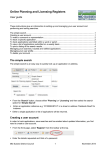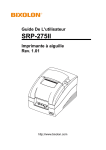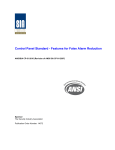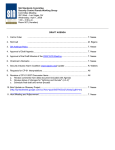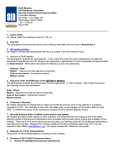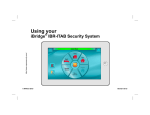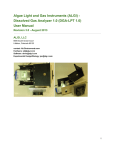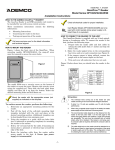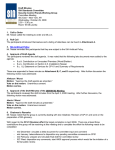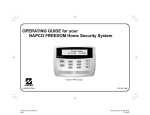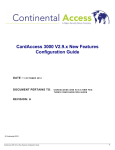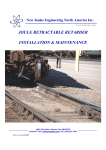Download Minutes_2006-10-24 - Security Industry Association
Transcript
Draft Minutes SIA Standards Committee Security Control Panels Subcommittee Meeting – New York, NY Tuesday, October 24, 2006 3:00 – 5:00 PM Jacob Javitts Convention Center – Room 2D06-2D07 1. Call to Order Mr. Nesse called the meeting to order at 3:05 p.m. 2. Roll Call The meeting attendees introduced themselves. A complete listing of the meeting participants can be found in Attachment A of these minutes. 3. SIA Antitrust Policy Ms. Vago referred participants to the SIA Antitrust policy linked to the agenda and reminded participants that they are subject to the policy. 4. Approval of Draft Agenda The participants reviewed the Agenda and after brief discussion the following motion was addressed: Hinkson / Salinas Motion: Approve the draft agenda as presented. Vote: Unanimous Motion Passes 5. Approval of the Draft Minutes of the 2006/04/06 Meeting The participants reviewed the minutes and after further discussion the following motion was addressed: Clary / Orlando Motion: Approve the draft minutes as presented. Vote: Unanimous Motion Passes 6. Chairman’s Remarks Mr. Nesse thanked the commenters for their review and comments of the document, it was excellent input. Mr. Nesse recommended that, if the committee agrees to make non-substantive changes based on the public review comments this document will move forward for final approval. If substantive changes are considered, the group may wish to consider them in a new revision effort. 7. Disposition of Public Review Comments The document underwent a public review from July 14-August 28, 2006. The comments received were appended to the draft agenda. The participants reviewed the comments in detail and their disposition is contained in Attachment B. After the review of the comments received the following motion was addressed: Salinas / Dischert Motion: To accept the disposition contained in Attachment B and noted that no substantive changes have been made to the draft. Vote: Unanimous Motion Passes 8. Electrical Disturbance Alarms Due to time constraints, this agenda item will be considered at the next meeting. 9. Open Discussion There was no further open discussion. 10. Next Meeting and Adjournment The meeting was adjourned (Hinkson / Dischert) at 5:20 p.m. The next meeting will be announced by staff to the Subcommittee. Attachment A – Attendee Listing for the October 24th, 2006 Control Panels Subcommittee Meeting ADT.............................................................................................................. Larry Dischert ADT.............................................................................................................. John Favia ADT.............................................................................................................. Bernie Worst AT&T............................................................................................................ Jimmy Salinas Bay Alarm .................................................................................................... Shane Clary Brinks........................................................................................................... Rick Sheets DMP............................................................................................................. Terry Shelton Honeywell .................................................................................................... Rich Hinkson Honeywell .................................................................................................... Robert Orlando Honeywell .................................................................................................... Scott Simon MasTec ........................................................................................................ George Bish Pelco............................................................................................................ Dan O’Malley Pelco............................................................................................................ Bob McKee SIAC ............................................................................................................ Ron Walters SES.............................................................................................................. Rick Muller Security Industry Association....................................................................... Monica Vago Security Industry Association Shaun Pal Smith Attachment B – Disposition of Public Review Comments Received Comments Received on Public Review (July 14, 2006 - August 28, 2006) for Draft ANSI/SIA CP-01 Revision http://www.siaonline.org/standards/cp/cp01_200x_20060627.pdf (Draft) http://www.siaonline.org/standards/cp/cp01_200x_20060627_delta.pdf (Draft with Markups) Comment Reference 20060828-1 Area of Document Annex B, Table B.1, Clause 4.2.2.1 Commentor Comment Disposition Substantive (Y/N) Tom Lewin ([email protected]) I understand, and agree, with the intent of the clause. My question is "If the selected exit time is set to the permitted 255 seconds, then can the 'doubled' time go to 510 seconds?" That extensive a delay seems possibly excessive. If the 'total doubled time' is not to exceed 255 seconds, that should be indicated in this clause. The new requirements for UL 1023 have been modified to 120 seconds (J. Lesniak). Would accept programmability outside the range. N NFPA 731 is in synch with current. 20060828-2 Clause 4.6.7.1, Auto Termination: Tom Lewin ([email protected]) How do you, or the control panel, know that auto testing will end 5 minutes into the future, and be finished then? I'm somewhat puzzled. 20060828-3 Page 46, VP26, Power Variations: Tom Lewin ([email protected]) Is this a procedure that is contemplated to be run in the field, after an installation is completed? Can this be done Committee agreed to edit document for further clarification in places where you double exit time “You double the exit time for a delay but not to exceed 255.” Committee agreed to no edits. The panel annunciates that it will time out of the test mode in 5 minutes. No warning is given if the user terminates the test mode manually. Committee agreed that the N N Comment Reference Area of Document Commentor 20060828-4 Page 48, VP38 Default Settings: Tom Lewin ([email protected]) 20060828-5 4.2.5.4.1 Cancel Larry Dischert, ADT ([email protected]) Comment Disposition practically by the installers? If this applies only to manufacturers, can they determine low-voltage operations for devices which they do not manufacture and will be installed by others? I'm confused. procedures are intended for use by the manufacturer to validate their design, and for use by UL to confirm compliance. But this is not explicitly stated. In light of the question, some explanatory text could be added to Annex D. SAME response to 20060828-3 above As I read this clause all testing is to be done at default settings. That being the case, how can the installer or the customer know that desired non-default value settings will be in effect at the end of the validation procedure? Am I missing something, or is that what is to be added in the "alternate procedure" item? The section starts out “If an alarm has previously been transmitted.” With the “delays” built in to CP-01 panels the alarm may not have been “previously” transmitted and as such a “cancel” may be transmitted at any time during an alarm event. (not sure how to word it). 20060828-6 3.2 Terms and definitions Larry Dischert, ADT ([email protected]) We think it is important to include language that clearly states that these terms are applicable to the CP-01 document, but may not be industry standards. Many of there terms are not the ones used by manufacturers, Committee agreed that a Cancel signal would be improper. As written it seems to correctly state that panels should not transmit a cancel signal if they did not transmit an alarm signal. They may optionally transmit an abort signal (see section 4.2.5.1.2 ). Committee agreed to further clarification described in Substantive (Y/N) N N N Comment Reference Area of Document Commentor Comment Disposition suppliers, or specifiers to describe the very same function. “something like” with a pointer to Annexx H. It now says “For the purposes of this standard, the following terms and definitions apply:”, but the implication is that these terms do apply to a panel that is labeled CP01 and this is not the case. Substantive (Y/N) Something like: “The terms and definitions listed below are for use within this standard in order to provide uniform use and understanding. They are not accepted industry nomenclature and individuals will find that various manufacturer’s will in fact use different terms to describe the same events or functions.” 20060828-7 4.6.1 Quick Reference Guide Larry Dischert, ADT ([email protected]) The listing of items to be included within the “guide” is not an all inclusive list of CP-01 features, and we believe it should be. We understand there are items, such as “swinger shutdown” that may be a little obscure to some users, however what we find is, it is the lack of readily available user documentation, describing some of these more obscure functions that leads to user confusion over exactly how a CP-01 panel behaves under various circumstances. It is also unlikely that the installer will explain these more obscure functions. Committee agreed that the list was selected to pull out those features that the user “interacts with”. Swinger Shut down will be added to the list. N But if there are specific additional features that should be described in the user manual they can be added. 20060828-8 4.6.1 Quick Reference, Note Larry Dischert, ADT ([email protected]) The “note” currently says “User manuals should contain the following statement, or one similar:” Agreed. N Committee agreed to add Cancel in Appendix H and add an N We believe the “should” must be a “shall” since it is intended that there be a statement and the only option is the exact wording, but a choice whether to include it or not is not intended. 20060828-9 Missing Subject Larry Dischert, ADT ([email protected]) Many of today’s panels have “generic function” (programmable) keys on the keypad. They may come labeled by the factory “function #1” or “reset” or whatever. These keys are often “programmed” with functions Comment Reference 20060828-10 Area of Document Terms and Definitions General Commentor Larry Dischert, ADT ([email protected]) Comment Disposition described within CP-01 (Such as “cancel”). It seems appropriate that the CP-01 standard should address the “marking” of these keys when they are used for CP-01 functions. appropriate definition for CP -01 and recommend to manufacturers to label function keys consistent with Appendix H; if required. Committee agreed that the effort described is laudable, however, beyond the scope of this effort; no edits are required. There was an effort underway by the CSAA and a while ago by the NBFAA to arrive at a “harmonized” listing of alarm industry terms (have not seen any activity from them). We now have the NFPA publishing their list of terms and they are all quite different. (For instance Duress, SIA=person holding gun to head, NFPA=civil disturbance, NFPA-Ambush=person holding gun to head). I realize this may not have been a committee goal, but I believe there was the expectation that the CSAA would complete this and there would be an opportunity to “harmonize.” I’m thinking maybe pose this question to the Panel committee and see it’s pleasure on this task? 20060828-11 4.2.7 Manual Alarms(third bullet) Bernie Worst, ADT ([email protected]) ADT would suggest the elimination of single button remote alarm devices. We have experienced many cases of false alarms with these devices. The 2-second activation time really is not much help in the situation described below. Additionally, if the customer is not aware of the 2 second, or in a panic forgets to hold, potential harm from not activating can exist. This is an excerpt from a recent message from one of our offices: We receive many false alarm activations from wireless, hand-held, hold-up buttons on small commercial installations. Many clients trigger them by placing them in their pockets, resulting in a false hold-up alarm response . .. 20060828-12 Appendix A Programmable Features Shipping Defaults "Cancel" Larry Dischert, ADT ([email protected]) Discovered that the “cancel” line in the matrix 4.2 5.4.1, does not contain the default value “minimum 5 minutes.” It can be found in the text 4.2.5.4, but it is inconsistent not to be included in the Default matrix. Substantive (Y/N) N The committee agreed that this was a good suggestion, however, consider this to be part of a new edition change. This item will be considered in a future revision that would be considered a new edition. N Committee agreed that the 5 minute minimum cancel window should be added to the table as a N Comment Reference Area of Document Commentor 20060828-13 4.1 Rich Hinkson, Honeywell ([email protected]) 20060828-14 4.2.2 Rich Hinkson, Honeywell ([email protected]) 20060828-15 4.2.2.1 Rich Hinkson, Honeywell ([email protected]) 20060828-16 4.2.2.3 Rich Hinkson, Honeywell ([email protected]) 20060828-17 4.2.2.4 Rich Hinkson, Honeywell ([email protected]) Comment Suggest changing the proposed “additional text” to something like: When silent exit is used in a partitioned system it shall meet the same requirements as for nonpartitioned systems. Suggest Replacing the proposed “additional text” with: An Auto-arming option may exist and when enabled must meet all of the requirements of clause 4. Suggest Removal of the statement in the SECOND paragraph entirely: This is a redundant statement as it is covered in paragraph 4 of 4.2.2.2 already Suggest replacing the proposed additional text with “Panels may have this feature disabled at the time of installation.” We propose changing the first sentence of this paragraph as follows: Disposition required feature. The table will note that it is a required feature, it is not required to be programmable.. Committee agreed, improves clarity. Committee agreed, improves the clarity and does not change the meaning Committee agreed, the second sentence of the second paragraph will be deleted. Committee agreed to the comment. Will replace proposed additional test to include the wording. Committee agreed. Substantive (Y/N) N N N N N Existing standard text An Exit Error sequence shall be initiated if an exit entry zone is violated at the expiration of exit time. Proposed changes An Exit Error sequence shall be initiated if an exit entry zone is in a violated state or condition at the instant of exit time expiration. 20060828-18 4.2.2.4 Rich Hinkson, Honeywell ([email protected]) Suggest Replacing the proposed “additional text” with: This section applies to entry/exit zones only. All non E/E type zones will adhere to the manufacturers Committee agreed. N Comment Reference Area of Document Commentor Comment 20060828-19 4.2.3.2 Rich Hinkson, Honeywell ([email protected]) specifications relative to Exit Error Suggest Removal of the Proposed word “ early” or defining what “early” means 20060828-20 4.2.3.3 Rich Hinkson, Honeywell ([email protected]) The “Deleted text box” does NOT accurately reflect what the actual cp01 2000 standard contains. 20060828-21 4.2.3.3 Rich Hinkson, Honeywell ([email protected]) Suggest the proposed “additional text”: “If multiple keypads are annunciating the entry delay, one or all of the keypads may be momentarily silenced” be moved to the end of this clause to be effective. We believe the point of this comment is to ensure that MULTIPLE pads can be silenced. 20060828-22 4.2.4.1 Rich Hinkson, Honeywell ([email protected]) Suggest removal of the proposed “additional text” entirely: We don’t understand the purpose of this statement. 20060828-23 4.2.4.2 Rich Hinkson, Honeywell ([email protected]) The reference to 4.2.7.1 should be a reference to 4.2.7 Suggest Replacement of the proposed “additional text” entirely with: Testing to comply with Manufacturers specification Disposition Substantive (Y/N) Committee agreed to remove the word “early”. Comment on deleted text; no action required nor to be taken. Committee agreed to exchange “all” for “more” and move the text to the end of the section. Change the text in the first paragraph to ALL buttoms prevent inadvertant activtation by some mechanical feature. Add new text that provides a distinction between buttons that trigger alarms (dual action requirement) and remote buttons that control the system (mechanical feature). Committee agreed that the reference change will be made and to replace the added text. N N N N N Comment Reference 20060828-24 Area of Document 4.2.4.3 20060828-25 4.2.5.1 Commentor Comment Disposition Substantive (Y/N) Rich Hinkson, Honeywell ([email protected]) Suggest Replacement of the proposed “Additional text” with: Acknowledgment of Arm and disarm may or may not be unique. A manufacturer may use the same acknowledgement for both functions if separate buttons are used for Arming and Disarming N Rich Hinkson, Honeywell ([email protected]) 1) The “deleted text box” was NOT in the cp01 standard. Proposed wording accepted. Capitalize “Disarm” in the first sentence. Committee agreed to the following: 1) Thanks for your comment; no change. 2) Agreed 3) Agreed Committee agreed to the following: 1) Thanks for your comment; no change. 2) Agreed N 2) We suggest Changing the “existing standards text” as follows: Existing text The abort window may be disabled by zone or zone type. Proposed change The abort window may be disabled for each zone or zone type individually for the entire system. N 3) We suggest Changing Proposed “ADDITIONAL text” as follows: Proposed Additional text It shall not be possible to globally disable the abort window 20060828-26 4.2.5.1.1 Rich Hinkson, Honeywell ([email protected]) Proposed change to additional text: It shall not be possible to globally disable the abort window using a single system-wide option 1) The “Deleted text box” was NOT in the cp01 2000 standard and has no place on this document. 2) We suggest Removal of the following proposed “additional text” entirely: If this is unsuccessful the local alarm….. Comment Reference 20060828-27 Area of Document 4.3.2 Commentor Comment Disposition Substantive (Y/N) Rich Hinkson, Honeywell ([email protected]) We suggest changing the word “trip” in the first sentence to “trip(s) ” We suggest removing the proposed “additional text” entirely. Restores may or may not be sent to the central station after the final alarm event as dictated by the manufacturer. Committee agreed to the following: 1) Accept change to trips. N We suggest “Adding the following text” to this section: The swinger count is decreased by alarm events only. No other event will reduce the counter. Therefore when swinger shutdown is set to 2, the system will allow 2 alarm transmissions to be sent to the central station, independent of any other signals it may send on that zone. Restore signals will not reduce the swinger counter. 2) This was suggested by UL and needs to stay; not accepted 3) Tabled to the next version of the standard - at that time the committee will need to decide if it is necessary to have logical separation between trouble and alarm swinger counts. Comment Reference 20060828-28 Area of Document 4.4.2 Commentor Comment Disposition Substantive (Y/N) Rich Hinkson, Honeywell ([email protected]) We suggest removal of proposed additional text entirely for the following reason: In order to properly match a sensor (i.e. PIR) to a panel you must consider current draw of the sensor, minimum operating voltage of the sensor, as well as line resistance. This calculation is installation specific and can not be provided by the manufacturer as a global statement. Discussion surrounding the last sentence: “The specification limit may be provided as either as a DC input voltage or a total field wiring circuit resistance beyond which proper operation of the zone is not assured.” N 20060828-29 4.5 Rich Hinkson, Honeywell ([email protected]) 20060828-30 4.6.1.1 Rich Hinkson, Honeywell ([email protected]) Paragraph 2: We suggest the proposed “additional text” be MOVED to the VALIDATION section (annex e) of the document. It does not belong in the body of the standard We suggest removal of the proposed “additional text” entirely for the following reasons: 1) This section may be interpreted by agencies as requiring that ALL peripherals must be tested to the cp01 standard. 2) This also suggests that new products or other manufacturers’ products (i.e. sensors) may not be installed on existing systems without being listed on this document first. For example, if a new replacement version of a keypad is developed, an AHJ could refuse to list the system since the model numbers would not match the documentation. This could easily create a paperwork Committee agreed to the following: Take added text out and then put in an informative Annex in the document. To ensure compatibility between zone inputs and the sensor outputs. Committee agreed. Good idea. Committee agreed to add explanatory text in an Annex on what is and what is not the intent of this section. N N Comment Reference Area of Document Commentor 20060828-31 4.6.7.1 Rich Hinkson, Honeywell ([email protected]) 20060828-32 Annex D Rich Hinkson, Honeywell ([email protected]) Comment nightmare We suggest the proposed “additional text” be removed entirely. The standard is clear as written and doest not require additional language. The indication of “automatic termination” indication was left to the discretion of the manufacturer and should remain that way. If desired, language can be added that specifically states this. Suggest adding titles between the various tests in VP25 as follows: VP25 Fire Alarms Verify that Verification may be disabled • • • Program the UUT to disable Fire Alarm Verification Trip a sensor on a fire zone. Verify that the UUT transmits an alarm signal. With Verification enabled, test that a single trip does not cause an alarm • Program the UUT to enable Fire Alarm Verification. • Trip a sensor on a fire zone that has been configured for alarm verification • For UUTs with a means for determining that a zone has been reset, verify that the UUT resets the zone. For self-resetting sensors, remove the tripping means after 5 seconds. Verify that no alarm is triggered within the time • frame designated by the manufacturer. Check that multiple trips on a sensor do trigger an alarm Wait for a period of 3 minutes to allow the • confirmation period to time out Trip a sensor on a fire zone that has been • configured for alarm verification For a UUT with a means for determining that a • zone has been reset, verify that the UUT resets the zone. When the zone is reset, trip it again within the time frame designated by the manufacturer. For self-resetting sensors, remove the tripping Disposition Substantive (Y/N) Committee agreed to not add additional text. N Committee accepted adding titles for clarification. N Comment Reference Area of Document Commentor Comment Disposition Substantive (Y/N) The committee opted for no change - this issue is effectively deferred to the next edition of the standard, which may have substantive changes that might require resubmittal. N Committee agreed; not less than fourteen days. N means 5 seconds after the sensor trips. Wait 15 seconds , then re-apply the tripping means and hold it • Verify that an alarm signal is transmitted after the second trip within the time frame designated by the manufacturer Check that a sustained trip on a sensor does trigger an alarm • • • 20060828-33 Annex F 4.2 Rich Hinkson, Honeywell ([email protected]) Reset the fire alarm system of the UUT Trip a sensor on a fire zone that has been configured for alarm verification. Hold the tripping means in place. Verify that an alarm signal is transmitted within the time frame designated by the manufacturer Passing products through agencies these days has become extremely challenging and burdensome. There are times when it takes a year to get a simple revision relisted. The proposition as stated will cause manufacturers to resubmit for agency approval ANY time there is a minor revision. Therefore we make the following suggestions We STRONGLY suggest replacing the proposed “additional text” with the following statements: Products listed to any CP01 standard will remain listed to that particular revision of the standard and need not be updated or re-tested to the latest CP01 revision when modified. 20060828-34 4.4.3, Restoration of Power Michael Carrieri ([email protected]) This requirement only allows for certain kinds of non-volatile storage and prohibits designs with only a week or two of capacitor backed up RAM. I am not sure why the term indefinitely was chosen but it clearly affects limited storage devices. Can a time period of say 5 days be used in lieu of infinitely?














